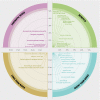Portrayal of caesarean section in Brazilian women's magazines: 20 year review
- PMID: 21266421
- PMCID: PMC3026601
- DOI: 10.1136/bmj.d276
Portrayal of caesarean section in Brazilian women's magazines: 20 year review
Abstract
Objective: To assess the quality and comprehensiveness of the information on caesarean section provided in Brazilian women's magazines.
Design: Review of articles published during 1988-2008 in top selling women's magazines.
Setting: Brazil, one of the countries with the highest caesarean section rates in the world.
Data sources: Women's magazines with the largest distribution during the study period, identified through the official national media indexing organisations.
Selection criteria: Articles with objective scientific information or advice, comments, opinions, or the experience of ordinary women or celebrities on delivery by caesarean section.
Main outcome measures: Sources of information mentioned by the author of the article, the accuracy and completeness of data presented on caesarean section, and alleged reasons why women would prefer to deliver though caesarean section.
Results: 118 articles were included. The main cited sources of information were health professionals (78% (n=92) of the articles). 71% (n=84) of the articles reported at least one benefit of caesarean section, and 82% (n=97) reported at least one short term maternal risk of caesarean section. The benefits most often attributed to delivery by caesarean section were reduction of pain and convenience for family or health professionals. The most frequently reported short term maternal risks of caesarean section were increased time to recover and that it is a less natural way of giving birth. Only one third of the articles mentioned any long term maternal risks or perinatal complications associated with caesarean section. Fear of pain was the main reported reason why women would prefer to deliver by caesarean section.
Conclusions: Most of the articles published in Brazilian women's magazines do not use optimal sources of information. The portrayal of caesarean section is mostly balanced, not explicitly in favour of one or another route of delivery, but incomplete and may be leading women to underestimate the maternal/perinatal risks associated with this route of delivery.
Conflict of interest statement
Competing interests: All authors have completed the Unified Competing Interest form at
Figures
References
-
- Althabe F, Sosa C, Belizan JM, Gibbons L, Jacquerioz F, Bergel E. Cesarean section rates and maternal and neonatal mortality in low-, medium-, and high-income countries: an ecological study. Birth 2006;33:270-7. - PubMed
-
- Belizan JM, Cafferata ML, Althabe F, Buekens P. Risks of patient choice cesarean. Birth 2006;33:167-9. - PubMed
-
- Lumbiganon P, Laopaiboon M, Gulmezoglu AM, Souza JP, Taneepanichskul S, Ruyan P, et al. Method of delivery and pregnancy outcomes in Asia: the WHO global survey on maternal and perinatal health 2007-08. Lancet 2010;375:490-9. - PubMed
-
- Villar J, Valladares E, Wojdyla D, Zavaleta N, Carroli G, Velazco A, et al. Caesarean delivery rates and pregnancy outcomes: the 2005 WHO global survey on maternal and perinatal health in Latin America. Lancet 2006;367:1819-29. - PubMed
Publication types
MeSH terms
LinkOut - more resources
Full Text Sources
Medical


